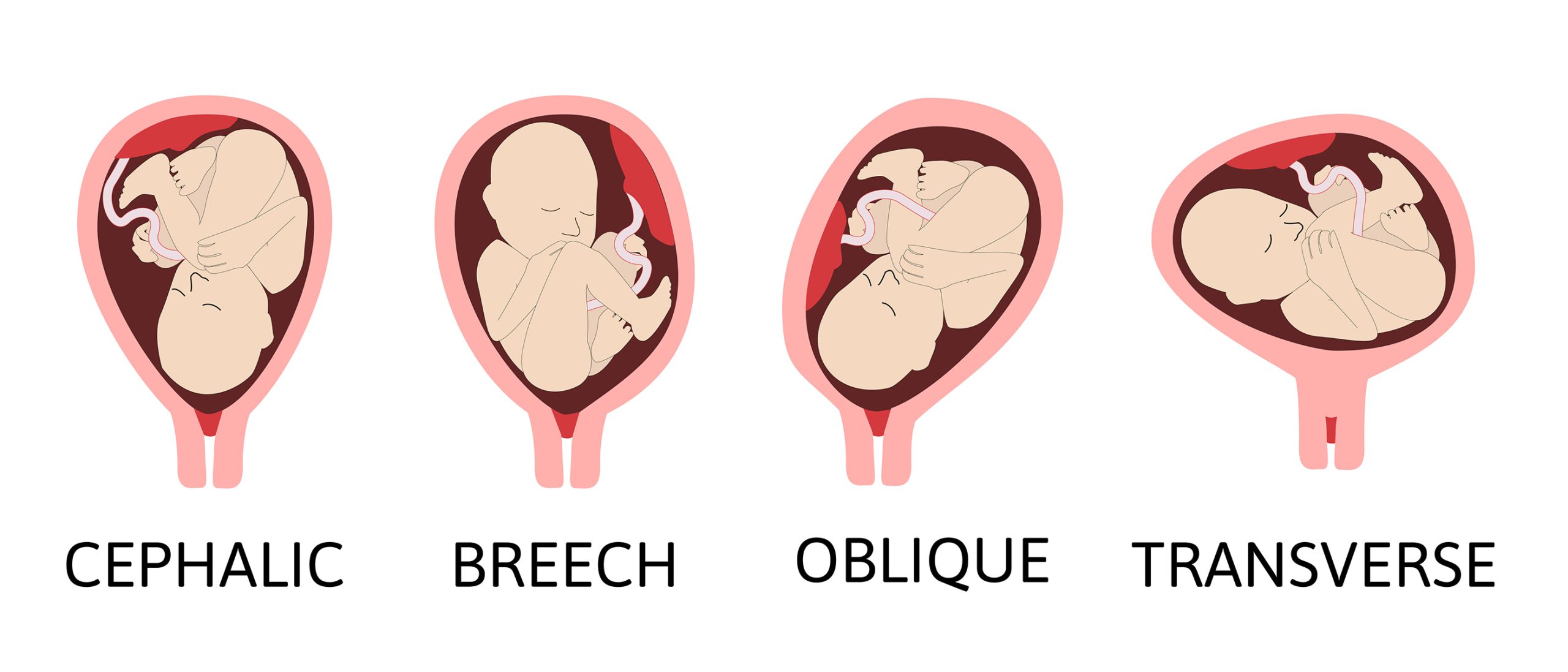Can ECV Cause Brain Damage?
Are you and your newborn child suffering from injury or harm due to a healthcare professional causing brain damage during an ECV procedure?
These injuries can be traumatic and result in severe consequences.
Working with Chicago Medical Malpractice Lawyers is the first step towards understanding ECV procedures and getting compensation for your pain.
Our attorneys understand birth injury lawsuit cases and will take on every aspect of your claim, ensuring that your needs and those of your loved ones will be taken care of in a timely fashion.

An external cephalic version or ECV is a procedure used to turn a breech baby into the head-down position before childbirth.
ECVs generally have a low risk of complications, but in rare cases, the procedure could lead to serious issues, such as brain damage to the baby.
Brain damage might occur if the procedure causes a lack of oxygen to the baby through cord compression or placental abruption.
However, these complications are extremely rare when ECV is performed in a controlled, medical environment with proper monitoring.
Doctors typically monitor both the mother and baby closely during and after the procedure to ensure their safety, reducing the risk of severe outcomes.

Tell Us About Your Case
Schedule your free case evaluation with Chicago Medical Malpractice Lawyers today
Our Experience With ECV Brain Damage Lawsuits
Chicago Medical Malpractice Lawyers are a Chicago-based law firm specializing in medical malpractice with extensive experience representing clients in cases involving birth injuries, including brain damage resulting from ECV procedures meant to reposition a baby into the heads-down position prior to labor and delivery.
Our Chicago birth injury lawyers team have successfully litigated numerous cases where patients suffered harm due brain damage that occurs during ECV procedures, securing compensation for medical expenses, lost wages, and pain and suffering.
Our expertise in this area often involves collaborating with medical experts to uncover negligence and advocate for their clients’ rights.
We focus on clients in Chicago, Illinois, and the surrounding areas.
Some examples of medical malpractice cases we’ve handled include settlements of over $1,000,000.
What is an ECV Procedure?

An ECV procedure refers to an External Cephalic Version procedure.
This is a labor and delivery procedure used to turn a baby from a breech position (feet or buttocks first) to a head-down position (cephalic position) before labor begins.
Approximately 3-4% of all childbirths are considered breech births.
The goal of an ECV is to reduce the need for a cesarean section (C-section) by helping the baby get into an optimal position to deliver vaginally.
What Is The Purpose Of An External Cephalic Version (ECV) Procedure?
The primary purpose of an External Cephalic Version (ECV) procedure is to turn a baby from a breech position, or a position where the baby’s feet or buttocks are positioned to come out first into a cephalic or “heads-down” position before labor.
It is also used to turn a baby from a transverse position to a more advantageous head-down position as well.
This headfirst position is optimal for a vaginal birth, and ECV is performed to increase the chances of avoiding a cesarean section (C-section).
Breech babies often result in planned C-sections (cesarean delivery) because a vaginal breech birth can pose higher risks.
By turning the baby head-down, the mother has a better chance of having a vaginal delivery, which is generally considered safer for both mother and baby.
It minimizes risks such as head entrapment or issues with the umbilical cord.
Delivering a baby in a breech or transverse position can lead to complications like prolonged labor, difficulty in delivering the shoulders, or injury to the baby during delivery.
ECV helps align the baby properly for a smoother delivery process.
A successful ECV may allow the mother to proceed with a vaginal delivery, which can reduce recovery time, lower the risk of complications, and decrease the likelihood of future C-sections.
In short, the goal of an ECV is to improve the chances of a healthy vaginal delivery and avoid potential complications associated with breech or transverse births.
How Is An ECV Performed?
An ECV is typically performed when the mother is 36 to 37 weeks pregnant if the baby is in a breech or transverse position.
To perform an ECV, the healthcare provider applies pressure on the mother’s abdomen to manually guide the baby into a head-down position.
An ultrasound device is often used before and during the procedure to check the baby’s position, monitor the baby’s heart rate, and assess the amount of amniotic fluid.
The mother may be given medication to relax the uterus and make it easier to move the baby.
What Are The Risks Of An ECV Procedure?
Although generally safe, the ECV procedure carries some risks, including:
- Fetal distress (which is why fetal heart rate is closely monitored during the procedure).
- Premature rupture of membranes (water breaking).
- Placental abruption (separation of the placenta from the uterus).
- Rarely, the procedure may lead to an emergency C-section if complications arise.
ECV is typically recommended when there are no contraindications, and the benefits of a potential vaginal delivery outweigh the risks.
Can An ECV Cause Brain Damage?
Brain damage could theoretically occur during an ECV procedure if the baby experiences severe distress or reduced oxygen supply during the procedure, but such cases are very uncommon.
The risks of serious complications are small, and doctors carefully monitor the mother and baby throughout the procedure to manage any potential issues.
If you’re considering or concerned about an ECV, it’s important to discuss your specific situation with your healthcare provider to weigh the risks and benefits.
What Is The Success Rate For ECV Procedures?
The success rate for an ECV varies, but is generally around 70%.
Factors such as the amount of amniotic fluid, the position of the placenta, and the experience of the healthcare provider can affect the outcome.
Why Is A C-Section Necessary When A Baby Is Breech?
A C-section (cesarean section) is often recommended when a baby is breech—meaning the baby is positioned with its feet or buttocks down in the womb—because vaginal delivery in this position can increase the risk of complications for both the mother and baby.
Here are the main reasons why a C-section may be necessary in these cases:
- Risk of Head Entrapment. In a breech birth, the baby’s body may be delivered first, but the head, which is the largest part, could become stuck in the birth canal. This can result in difficulty delivering the baby’s head, leading to a lack of oxygen for the baby.
- Umbilical Cord Prolapse or Compression. As the baby descends in the breech position, the umbilical cord can slip into the birth canal and become compressed, cutting off the baby’s oxygen supply. This can lead to brain damage or other serious health issues.
- Fetal Distress. Vaginal delivery of a breech baby can put additional stress on the baby, sometimes leading to fetal distress, where the baby shows signs of oxygen deprivation. A C-section can be a safer option to reduce this risk.
- Trauma to Baby’s Body Parts. In some breech deliveries, parts of the baby’s body like the legs, arms, or hips could be injured during vaginal birth due to the abnormal position, particularly if the baby is a footling breech (feet first).
- Reduced Control Over Delivery Process. Vaginal delivery of a breech baby can be more unpredictable and complicated than a C-section. A C-section provides the medical team with greater control over the delivery process, making it a safer option in many cases.
While some breech babies can be delivered vaginally under very specific circumstances, most healthcare providers recommend a C-section for breech presentations to minimize the risk to both the mother and the baby.
Common Birth Injuries During Breech Births
Breech births, where the baby is positioned feet or buttocks first, can lead to a higher risk of certain birth injuries compared to head-down (cephalic) deliveries.
Here are some common birth injuries associated with breech births:
- Intracranial Hemorrhage (Brain Bleeding). When the head is delivered last, there’s a risk of excessive pressure on the baby’s skull, which can cause brain bleeding. This can lead to neurological issues, including brain damage.
- Head Entrapment. Since the baby’s body is delivered first and the head comes out last, there is a risk that the head may get stuck in the birth canal since it is the largest part. This can lead to oxygen deprivation, which may result in brain damage if not resolved quickly.
- Umbilical Cord Prolapse. In a breech delivery, the umbilical cord may slip into the birth canal before the baby’s body (a cord prolapse), leading to compression of the cord. This reduces oxygen and blood flow to the baby, which can lead to hypoxia (oxygen deprivation), brain injury, or even stillbirth.
- Birth Trauma (Fractures, Dislocations). The baby’s shoulders, arms, or legs may be injured during delivery as they are delivered before the head, leading to fractures or dislocations, particularly of the shoulders or hips. This can cause long-term physical damage, although some injuries like fractures can heal without long-term issues.
- Brachial Plexus Injury. A brachial plexus injury occurs when the nerves controlling movement and sensation in the baby’s arms are stretched or torn during delivery. This can happen if the baby’s arms are positioned awkwardly or pulled during a breech delivery. It can result in temporary or permanent weakness or paralysis of the affected arm (Erb’s palsy).
- Spinal Cord Injury. Breech deliveries, especially when the baby’s body is manipulated to facilitate delivery, can put pressure on the baby’s spine. Although rare, spinal cord injuries can occur, leading to nerve damage or paralysis.
- Hypoxia (Oxygen Deprivation) or HIE. Oxygen deprivation can happen during any difficult delivery but is a particular concern in breech births due to cord prolapse or delays in delivering the head. If the baby is deprived of oxygen for too long, it can lead to brain damage, resulting in conditions like cerebral palsy.
- Facial or Genital Injuries. During a breech birth, the baby’s face or genital area may be more prone to injury due to their positioning and the stress of passing through the birth canal. These injuries are typically minor but can cause bruising or swelling.
- Fetal Distress. Breech babies are more likely to experience fetal distress due to the prolonged or difficult nature of the delivery. Fetal distress can indicate oxygen deprivation or other serious issues that require immediate medical intervention, such as an emergency C-section.
For these reasons, many doctors recommend a C-section for breech presentations, as it reduces the risks of these injuries and ensures a safer delivery.
However, with proper monitoring and skilled care, some breech babies can be delivered vaginally with fewer complications.
Three Main Types Of Breech Positions

There are three main types of breech positions, each based on how the baby is positioned in the womb:
Frank Breech
The baby’s buttocks are positioned to come out first, with the legs stretched straight up in front of the baby’s body, and the feet are near the baby’s head.
This is the most common type of breech presentation, occurring in about 50-70% of all breech births.
Frank breech babies are sometimes considered for vaginal delivery if all other conditions are favorable.
Complete Breech
The baby’s buttocks are also positioned to come out first, but unlike the frank breech, the baby’s knees are bent, and the feet are near the buttocks in a “cross-legged” or sitting position.
This position is the least common than frank breech and represents around 5-10% of breech births.
Vaginal delivery is possible, but more challenging than with a head-first presentation.
Footling Breech (or Incomplete Breech)
One or both of the baby’s feet are positioned to come out first, with the baby’s buttocks higher in the birth canal.
In a single footling breech, one foot is leading, while in a double footling breech, both feet are leading.
This type of breech is more rare, occurring in about 10-30% of breech births.
Footling breech is generally not considered safe for vaginal delivery because of the higher risk of cord prolapse or injury during birth, so a C-section is typically recommended.
Understanding the baby’s breech position is important for determining the safest delivery method.
Frank and complete breech positions may sometimes allow for vaginal delivery, but footling breech often necessitates a C-section due to the associated risks.
Why Would A Baby Be In The Breech Position?
A baby can be in the breech position for several reasons, and while it’s common for babies to be breech earlier in pregnancy, most will turn into the head-down position by around 36 weeks.
Here are some common factors that can contribute to a baby remaining in the breech position closer to delivery:
- Prematurity. Babies born prematurely (before 37 weeks) often have not yet had the chance to turn into the head-down position, as this typically occurs in the final weeks of pregnancy. Early birth increases the likelihood that the baby will still be in a breech position.
- Uterine Abnormalities. Some women have a uterus with an unusual shape or abnormalities, such as a bicornuate uterus (heart-shaped) or fibroids (noncancerous growths). These conditions can limit the space available for the baby to turn and can prevent the baby from rotating into the proper head-down position.
- Too Much or Too Little Amniotic Fluid. Amniotic fluid plays a role in helping the baby move and turn inside the womb. When there is too much amniotic fluid (polyhydramnios) or too little (oligohydramnios), the baby may have difficulty shifting positions. Excess fluid allows the baby too much freedom of movement, while insufficient fluid restricts movement, both of which may result in the baby staying in a breech position.
- Multiple Pregnancies (Twins, Triplets, Or More). In pregnancies with more than one baby, the space inside the womb is limited, making it harder for the babies to move into the head-down position. One or more of the babies may remain in the breech position as a result of crowded conditions.
- Placenta Previa. In placenta previa, the placenta is positioned low in the uterus, sometimes covering part or all of the cervix. The low placement of the placenta can block the baby from moving into a head-down position, leading to a breech presentation.
- Baby’s Size Or Position. Sometimes the size or position of the baby itself can contribute to a breech presentation. A large baby may have difficulty turning around in the uterus, especially if there is limited space.. The baby may become “stuck” in a breech position as a result of their size or entanglement with the umbilical cord.
- Short Umbilical Cord. If the umbilical cord is shorter than usual, it may limit the baby’s ability to move freely inside the womb. This can restrict the baby’s ability to turn into the head-down position, leading to a breech presentation.
- Previous Breech Delivery. Women who have had a previous baby in the breech position may be at higher risk of having another breech baby, though the reasons for this are not entirely understood. Certain factors in the mother’s body, such as uterine shape or genetic factors, could predispose future pregnancies to breech positions.
- Abnormalities In The Baby. Rarely, physical abnormalities in the baby, such as conditions affecting the baby’s head or neck, may prevent the baby from turning into the proper head-down position. These physical issues can lead to the baby remaining in the breech position.
In most cases, the exact cause of a breech position is unknown, but understanding these factors can help determine the best course of action for delivery.
If a baby remains in the breech position late in pregnancy, medical interventions like an external cephalic version or ECV may be attempted to turn the baby, or a C-section may be recommended for a safer delivery.
Definitions And Background Information On ECV Brain Damage Lawsuits
- What is an ECV procedure?
An External Cephalic Version (ECV) is a procedure in which a healthcare provider manually turns a breech or sideways-positioned baby into a head-down position before delivery.
- What are the risk factors for an ECV procedure?
Risk factors for an ECV procedure include placental abruption, premature rupture of membranes, or fetal distress during the procedure.
Other factors, such as low amniotic fluid levels, uterine abnormalities, or a large baby, may increase the difficulty or risk of a failed version.
- How long do you have to file a claim for brain damage or other birth injury that occurs during an ECV procedure?
The time you have to file a claim for brain damage or other birth injuries resulting from an ECV procedure depends on the state’s statute of limitations for medical malpractice claims.
In many states including Illinois, the statute of limitations for injuries to minors can be extended, often allowing claims to be filed until the child reaches a certain age (commonly 18 or later), but this varies by state.
It’s important to consult with an attorney who specializes in medical malpractice for specifics based on your location.
- Can you file a claim against a doctor for brain damage during an ECV?
Yes, you can file a claim against a doctor for brain damage that occurs during an ECV procedure if there is evidence that the doctor was negligent.
To succeed in a medical malpractice claim, you generally need to prove that the doctor breached the standard of care, and that this breach directly caused the injury (e.g., brain damage).
If you think you have a claim, the next step is to consult a medical malpractice attorney to assess the specifics of the case, gather expert testimony, and determine if negligence occurred.
- Can you file a claim against your OB for a birth injury during an ECV?
Yes, it’s possible to file a claim against an obstetrician (OB) for brain damage or another birth injury that occurs during an ECV procedure if there’s evidence of negligence or malpractice that led to the injury.
These types of complications can have long-lasting consequences for both the child and the family, so it’s important to seek legal advice if you believe negligence played a role.
- Can you file a claim against a hospital for a birth injury that occurs during an ECV procedure?
Yes, you can file a claim against a hospital for a brain damage or another birth injury that occurred during an ECV procedure if you believe it resulted from negligence, improper procedures, inadequate staffing, or other failures on the part of the hospital or its staff.
- Will confirmed brain damage post-EVC procedure automatically lead to a valid legal claim against the health care provider?
Confirmed brain damage or another birth injury does not automatically guarantee a valid legal claim against the healthcare provider.
While the injury is a crucial factor in a potential medical malpractice claim, establishing liability requires demonstrating that it resulted from the healthcare provider’s negligence or failure to meet the accepted standard of care.
A thorough investigation, supported by medical evidence and expert testimony, is necessary to establish the elements of medical malpractice and pursue a successful legal claim.
- What are the long term impacts of brain damage that occurs during an ECV procedure?
Brain damage can have lifelong consequences, impacting the child’s physical health, cognitive development, and overall quality of life.
They may require ongoing medical care, rehabilitation, and support services.
- If I die or my child dies as a result of an ECV procedure, will the claim die as well?
If you or your child die as a result of a birth injury that occurs during an ECV procedure, your claim may transition to a wrongful death claim, allowing certain family members or beneficiaries to pursue legal action on your behalf.
- How long do I have to file a lawsuit, and how long is it likely to take before I receive compensation?
The time limit to file a lawsuit for brain damage originating during an ECV procedure varies by jurisdiction, typically ranging from 1 to 6 years, while the duration to receive compensation can vary significantly depending on factors such as case complexity and negotiations, potentially taking months to several years.
In Illinois, the statute of limitations for filing any kind of birth injury claim is typically within 8 years of the date of the injury, or before the child’s 22nd birthday, whichever is later.
- Does Illinois apply any limits on medical malpractice damages?
Illinois does not have statutory limits or caps on medical malpractice damages, meaning there is no cap on the amount of compensation that can be awarded for economic or non-economic damages in medical malpractice cases.
However, it’s essential to consult with a top medical malpractice attorney or check for any updates in the law prior to making a claim, as regulations can change over time.
- How much compensation can I receive in an ECV procedure lawsuit?
The amount of compensation you can receive in a ECV procedure-related birth injury lawsuit in Illinois and elsewhere varies widely depending on factors such as the severity of the injury, the long-term impact on the child and family, medical expenses, lost income, and pain and suffering.
Settlements or jury awards can range from thousands to millions of dollars. Consulting with a qualified attorney who specializes in birth injury cases in your area can provide a better estimate based on the specific circumstances of your case.
- What to do if you think your child has experienced brain damage or other birth injury?
If you or your child have suffered from any kind of birth injury, consider seeking a second opinion from another healthcare provider, gather all relevant medical records and documentation, and consult with a qualified medical malpractice attorney to explore your legal options.
- How do you prove that brain damage occurred in a newborn?
Proving that such an injury occurred involves gathering medical records, consulting with medical experts, and conducting a thorough review of the circumstances surrounding the childbirth process.
Medical evidence such as diagnostic tests, imaging studies, and expert testimony can help establish the extent of the injury and its likely cause.
Documenting any deviations from the accepted standard of care, such as errors in medical judgment or failure to respond appropriately to complications during labor and delivery, is crucial in demonstrating medical negligence and establishing liability for brain damage or any other type of birth injury.
- When a birth injury during an ECV procedure is listed on an insurance claim form for childbirth, what will happen?
When any kind of injury is listed on an insurance claim form, the insurance company will typically review the claim to assess liability and determine coverage.
Depending on the circumstances, they may conduct their own investigation, request additional information or documentation, and may ultimately approve or deny the claim based on the terms of the policy and their assessment of the situation.
If the claim is approved, the insurance company may provide compensation to cover medical expenses and other damages resulting from the injury, subject to the limits of the policy and any applicable deductibles or copays.
If the claim is denied, the claimant may have the option to appeal the decision or pursue other avenues for seeking compensation, such as filing a lawsuit against the responsible parties.
- How many ECV procedures result in brain damage during childbirth per year?
The exact number of birth injuries per year can vary depending on various factors such as region, healthcare practices, and population demographics. Birth injuries are relatively rare, occurring in a small percentage of births.
In the United States, for example, it’s estimated that only 1-2% of ECV procedures result in complications.
However, these figures can fluctuate over time and may be influenced by improvements in obstetric care, advances in medical technology, and efforts to reduce the risk of complications during childbirth.
- My doctor caused brain damage to my newborn during an ECV. Now what?
If you believe your doctor caused brain damage or a related birth injury, the first step is to seek immediate medical attention for your child to address any urgent medical needs.
It’s also essential to gather and organize all relevant medical records and documentation related to the childbirth process and the injury sustained.
Next, consult with a qualified attorney experienced in medical malpractice and birth injury (ideally specifically complications related to procedures like External Cephalic Versions) cases in your jurisdiction to discuss your legal options.
Your attorney can help you understand your rights, navigate the legal process, and pursue compensation for the damages incurred as a result of the birth injury, including medical expenses, pain and suffering, and other losses.
- Can you file a claim for brain damage in a newborn?
Yes, you can file a claim for brain damage that occurs during an ECV if you believe that the injury resulted from medical negligence or malpractice during prenatal care, labor, or delivery.
Filing a claim allows you to seek compensation for the damages incurred as a result of this type of birth injury, including medical expenses, pain and suffering, and other losses.
It’s advisable to consult with a qualified attorney experienced in medical malpractice and birth injury cases in your area to understand your legal rights and options for pursuing a claim.
Find Out If You Have An ECV Brain Damage Case In Chicago, Illinois
Do you think you have a medical malpractice case based on an ECV procedure performed during a breech birth that occurred in Illinois?
If you are located in Chicago or the surrounding areas, contact the experienced medical malpractice attorneys now.
Tell Us About Your Case
Legally Reviewed By

Adam J. Zayed
Adam J. Zayed, the founder and managing trial attorney of Chicago Medical Malpractice Lawyers, and a nationally recognized and award-winning personal injury and medical malpractice trial attorney.

Chicago Medical Malpractice Lawyers
833 W Chicago Ave., Suite 303
Chicago, IL 60642
Tel: 312.883.6907
Fax: 312.481.7927
Related Links
- Chicago Birth Injury
- Chicago Cerebral Palsy Lawyer
- Birth Asphyxia
- Lack of Oxygen at Birth
- Wrongful Birth Lawsuit
- Newborn Seizures Attorney
- Wrongful Pregnancy Lawsuit
- Forceps Delivery Complications
- Shoulder Dystocia
- Shoulder Dystocia Complications
- Newborn Neck Injury Symptoms
- Still Birth Compensation Claims
- Can EVC Cause Brain Damage?
- Can Vacuum Delivery Cause Brain Damage?
- Labor and Malpractice Settlements
- Signs of Brain Damage in Premature Babies
